If you're seeking flexibility, you could be considering a temporary car insurance policy. But short-term car insurance is uncommon for multiple reasons.
Some major insurers won't offer contracts for less than six months. Since auto insurance is required in most places in the US, it can be risky to jump between policies. You also run the risk of creating gaps in your insurance record by making abrupt moves between policies, leading to higher rates down the road.
Thankfully, auto insurance contracts typically run for just half of a year. This hasty turnaround allows auto insurance companies to frequently “re-rate” — or re-price — the policy based on your present driving profile and demographic info.
The end of a policy period also provides the perfect opportunity for you to reevaluate your situation and shopping other insurers. Comparing rates online is easy and free, and there is no penalty for swapping auto insurance companies between policies — or even in the middle of your policy period, assuming you never let your coverage lapse.
The flexible nature of car insurance makes it relatively easy to purchase with little notice. If you require a policy before you can drive a car away, attempting to get a policy for a longer-term rental or seeking coverage for a car you don't own but regularly drive, consider purchasing a policy and cutting the term short as needed.
Compare car insurance rates today!
Temporary insurance in Oklahoma
Below are average car insurance costs in Oklahoma, organized by popular insurers and the most populous cities. If your premiums exceed what you see below, consider other options.
SHORT-TERM CAR INSURANCE RATES IN OKLAHOMA — BY INSURER
| Insurance Company | Average 6-Month Rate | Average Monthly Rate |
| Oklahoma State Average — All Companies | $893 | $149 |
| USAA | $683 | $114 |
| Oklahoma Farmers Union | $690 | $115 |
| Progressive | $738 | $123 |
| State Farm | $751 | $125 |
| GEICO | $925 | $154 |
The cheapest option for temporary auto insurance in Oklahoma is USAA, which can save you $1 per month, compared to the next-best option, Oklahoma Farmers Union. In Oklahoma, the average monthly cost of auto insurance is $149, or $893 over a six-month period.
Where you drive can have as great an impact on your insurance premiums as your choice of insurance company. Auto insurance companies consider the density and likelihood of a claim being filed when pricing policies by ZIP. See below insurance premiums in the largest Oklahoma cities and compare the amount you’re paying.
TEMPORARY CAR INSURANCE RATES IN OKLAHOMA — BY CITY
| Location | Average 6-Month Rate | Average Monthly Rate |
| Oklahoma City | $996 | $166 |
| Tulsa | $1,003 | $167 |
| Norman | $922 | $154 |
| Broken Arrow | $942 | $125 |
| Lawton | $844 | $141 |
Because so many factors are involved in setting insurance rates, your quotes may not match the totals displayed above. If your current costs exceed those listed above, take some time to weigh your options. The short-term nature of an auto insurance policy increases the importance of staying in-the-know and ready to shop.
Discover more about temporary auto insurance or use The Zebra to compare policies for free online.
Related content
- Learn more about weekend-only car insurance.
- Is it possible to get car insurance with no credit history?
- Find cheap auto insurance for new drivers.
- Check out the best car insurance options for teen drivers.
About The Zebra
The Zebra is not an insurance company. We publish data-backed, expert-reviewed resources to help consumers make more informed insurance decisions.
- The Zebra’s insurance content is written and reviewed for accuracy by licensed insurance agents.
- The Zebra’s insurance content is not subject to review or alteration by insurance companies or partners.
- The Zebra’s editorial team operates independently of the company’s partnerships and commercialization interests, publishing unbiased information for consumer benefit.
- The auto insurance rates published on The Zebra’s pages are based on a comprehensive analysis of car insurance pricing data, evaluating more than 83 million insurance rates from across the United States.





